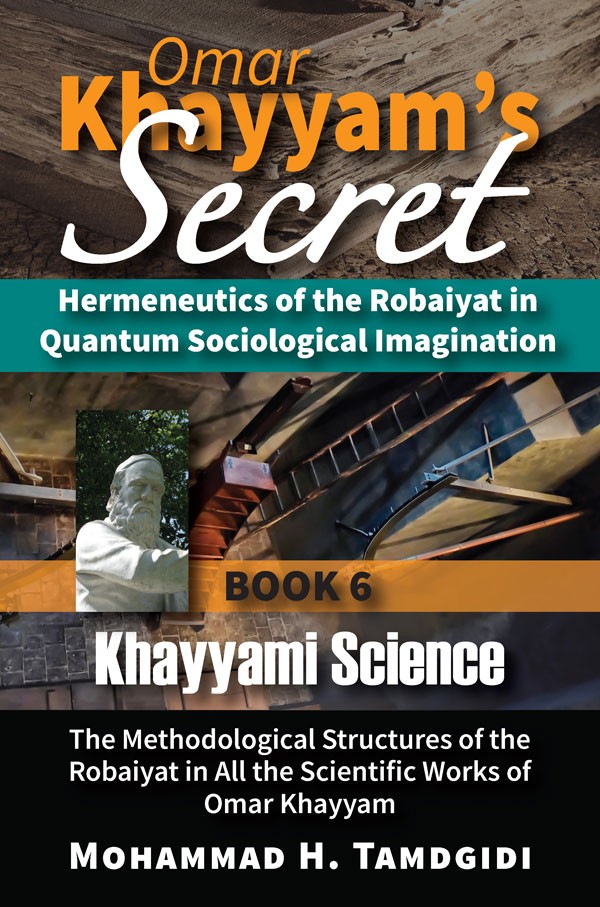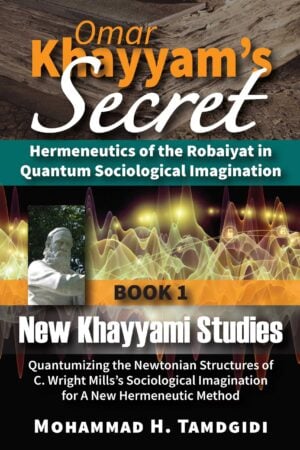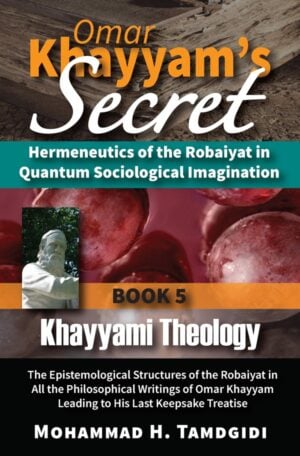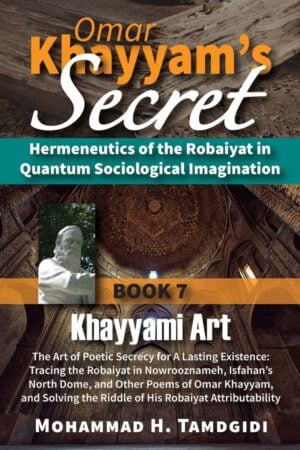Book Section: BACKMATTER — Including the Conclusion to “Omar Khayyam’s Secret” Series: Book 6: Khayyami Science — by Mohammad H. Tamdgidi
$20.00
This includes the conclusion and backmatter of Book 6 of the Omar Khayyam’s Secret series. The essay, titled “Conclusion to Book 6: Summary of Findings,” serves as the conclusion to the book Khayyami Science: The Methodological Structures of the Robaiyat in All the Scientific Works of Omar Khayyam, which is the sixth volume of the twelve-book series Omar Khayyam’s Secret: Hermeneutics of the Robaiyat in Quantum Sociological Imagination, authored by Mohammad H. Tamdgidi.
Description
Abstract
This includes the conclusion and backmatter of Book 6 of the Omar Khayyam’s Secret series.
The essay, titled “Conclusion to Book 6: Summary of Findings,” serves as the conclusion to the book Khayyami Science: The Methodological Structures of the Robaiyat in All the Scientific Works of Omar Khayyam, which is the sixth volume of the twelve-book series Omar Khayyam’s Secret: Hermeneutics of the Robaiyat in Quantum Sociological Imagination, authored by Mohammad H. Tamdgidi.
In Book 6, Tamdgidi shared the Arabic texts, his new English translations (based on others’ or his new Persian translations, also included in the volume), and hermeneutic analyses of five extant scientific writings of Khayyam: a treatise in music on tetrachords; a treatise on balance to measure the weights of precious metals in a body composed of them; a treatise on dividing a circle quadrant to achieve a certain proportionality; a treatise on classifying and solving all cubic (and lower degree) algebraic equations using geometric methods; and a treatise on explaining three postulation problems in Euclid’s book Elements.
Khayyam wrote three other non-extant scientific treatises on nature, geography, and music, while a treatise in arithmetic is differently extant since it influenced the work of later Islamic and Western scientists. His work in astronomy on solar calendar reform is also differently extant in the calendar used in Iran today. A short tract on astrology attributed to him has been neglected.
The first chapter of the book was titled, “Omar Khayyam’s Treatise in Music on Tetrachords: The Arabic Text and New Persian and English Translations, Followed by Textual Analysis.”
The second chapter of the book was titled, “Omar Khayyam’s Treatises on the Straight Balance and on How to Use a Water Balance to Measure the Weights of Gold and Silver in a Body Composed of Them: The Arabic Texts and New Persian and English Translations, Followed by Textual Analysis.”
The third chapter of the book was titled, “Omar Khayyam’s Treatise on Dividing A Circle Quadrant: The Arabic Text, the Persian Translation by Gholamhossein Mosaheb, and A New English Translation, Followed by Textual Analysis.”
The fourth chapter of the book was titled, “Omar Khayyam’s Treatise on the Proofs of Problems in Algebra and Equations: The Arabic Text, the Persian Translation by Gholamhossein Mosaheb, and Its New English Translation, Followed by Textual Analysis.”
The fifth chapter of the book was titled, “Omar Khayyam’s Treatise on the Explanation of Postulation Problems in Euclid’s Work: The Arabic Text, the Persian Translation by Jalaleddin Homaei, and Its New English Translation, Followed by Textual Analysis.”
And the sixth chapter of the book was titled, “The Robaiyat As a Critique of Fatalistic Astrology: Understanding Omar Khayyam’s Astronomy in Light of His Own Philosophical, Theological, and Scientific Outlook.”
Tamdgidi studied the scientific works in relation to Khayyam’s own theological, philosophical, and astronomical views. The study revealed that Khayyam’s science was informed by a unifying methodological attention to ratios and proportionality. So, likewise, any quatrain he wrote cannot be adequately understood without considering its place in the relational whole of its parent collection. Khayyam’s Robaiyat was found to be, as a critique of fatalistic astrology, his most important scientific work in astronomy rendered in poetic form.
In Tamdgidi’s view, studying Khayyam’s scientific works in relation to those of other scientists out of the context of his own philosophical, theological, and astronomical views, would be like comparing the roundness of two fruits while ignoring that they are apples and oranges. Khayyam was a relational, holistic, and self-including objective thinker, being systems and causal-chains discerning, creative, transdisciplinary, transcultural, and applied in method. He applied a poetic geometric imagination to solving algebraic problems and his logically methodical thinking did not spare even Euclid of criticism. His treatise on Euclid unified numerical and magnitudinal notions of ratio and proportionality by way of broadening the notion of number to include both rational and irrational numbers, transcending its Greek atomistic tradition.
Khayyam’s classification of algebraic equations, being capped at cubic types, tells of his applied scientific intentions that can be interpreted, in the context of his own Islamic philosophy and theology, as an effort in building an algebraic and numerical theory of everything that is not only symbolic of body’s three dimensions, but also of the three-foldness of intellect, soul, and body as essential types of a unitary substance created by God to evolve relatively on its own in a two-fold succession order of coming from and going to its Source. Although the succession order poses limits, as captured in the astrological imagination, existence is not fatalistic.
Khayyam’s conceptualist view of the human subject as an objective creative force in a participatory universe allows for the possibility of human self-determination and freedom depending on his or her self-awakening, a cause for which the Robaiyat was intended. Its collection would be a balanced unity of wisdom gems ascending from multiplicity toward unity using Wine and various astrological, geometrical, numerical, calendrical, and musical tropes in relationally classified quatrains that follow a logical succession order.
Recommended Citation
Tamdgidi, Mohammad H. 2023. “BACKMATTER — Including the Conclusion to “Omar Khayyam’s Secret” Series: Book 6: Khayyami Science.” Pp. 676-798 in Omar Khayyam’s Secret: Hermeneutics of the Robaiyat in Quantum Sociological Imagination: Book 6: Khayyami Science: The Methodological Structures of the Robaiyat in All the Scientific Works of Omar Khayyam. (Human Architecture: Journal of the Sociology of Self-Knowledge: Vol. XIX, 2023. Tayyebeh Series in East-West Research and Translation.) Belmont, MA: Okcir Press.
Where to Purchase Complete Book: The various editions of the volume of which this Book Section is a part can be ordered from the Okcir Store and all major online bookstores worldwide (such as Amazon, Barnes&Noble, Google Play, and others).
Read the Above Publication Online
To read the above publication online, you need to be logged in as an OKCIR Library member with a valid access. In that case just click on the large PDF icon below to access the publication. Make sure you refresh your browser page after logging in.








